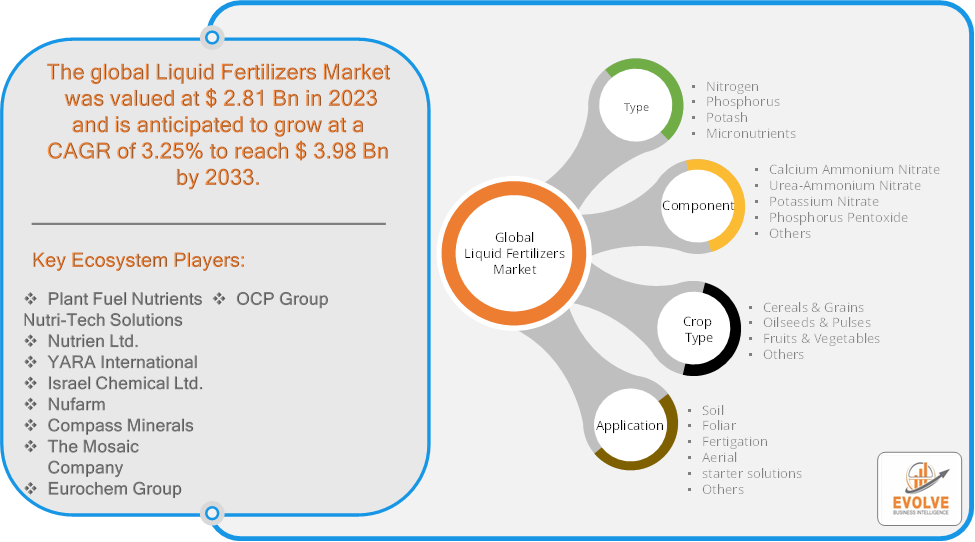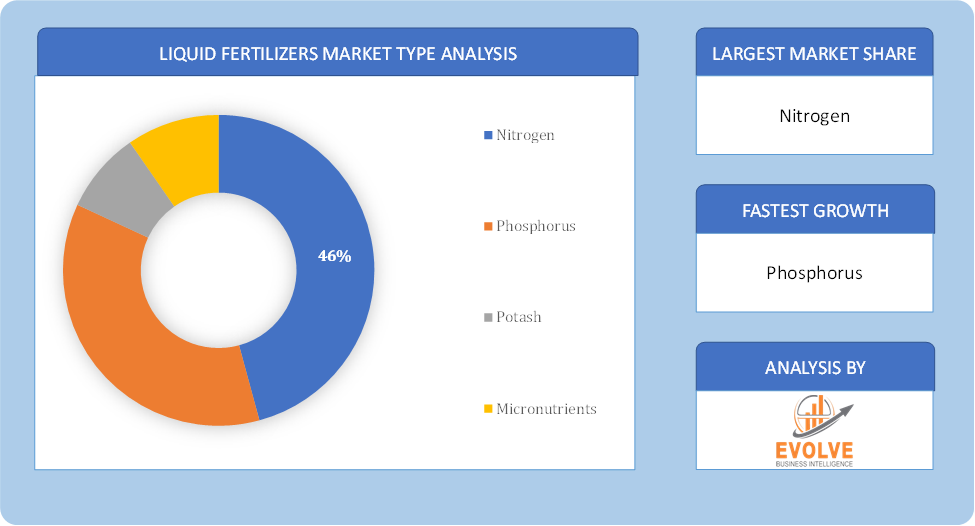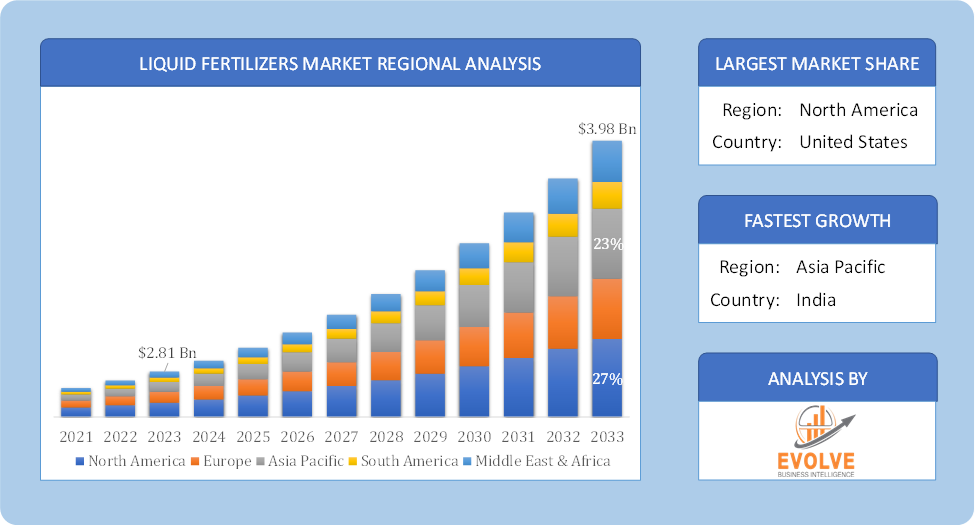Liquid Fertilizers Market Overview
The Liquid Fertilizers Market Size is expected to reach USD 3.98 Billion by 2033. The Liquid Fertilizers Market industry size accounted for USD 2.81 Billion in 2023 and is expected to expand at a compound annual growth rate (CAGR) of 3.25% from 2023 to 2033. The Liquid Fertilizers Market refers to the market for fertilizers that are in liquid form, typically dissolved in water for application to crops. These fertilizers contain nutrients essential for plant growth, such as nitrogen, phosphorus, and potassium, along with micronutrients like iron, zinc, and manganese. Liquid fertilizers are applied through irrigation systems or as foliar sprays, offering advantages such as ease of application, uniform nutrient distribution, and rapid absorption by plants. This market caters to agricultural and horticultural sectors globally, addressing the need for efficient nutrient management and maximizing crop yields.
The liquid fertilizers market is expected to witness significant growth in the coming years due to factors such as increasing global population, rising food demand, and growing adoption of sustainable farming practices. Advancements in fertilizer technology and the development of specialized products for specific crop needs will also contribute to market expansion.
Global Liquid Fertilizers Market Synopsis
 COVID-19 Impact Analysis
COVID-19 Impact Analysis
The COVID-19 pandemic had significant impacts on the Liquid Fertilizers Market. Restrictions on movement and trade disrupted supply chains, affecting the availability of raw materials and distribution of liquid fertilizers. Initially, there were uncertainties leading to fluctuations in demand as farmers adjusted planting schedules and budgets. However, agriculture was deemed essential, mitigating some demand shocks. Some farmers adapted to the uncertainty by altering their cropping patterns or delaying purchases, impacting the timing and volume of liquid fertilizer applications. The pandemic highlighted the importance of food security, potentially driving investments in agriculture and sustainable farming practices, including the use of liquid fertilizers.
Liquid Fertilizers Market Dynamics
The major factors that have impacted the growth of Liquid Fertilizers Market are as follows:
Drivers:
Ø Technological Advancements
Innovations in formulation and application technologies improve the effectiveness and compatibility of liquid fertilizers with modern agricultural practices. Their ability to deliver nutrients directly to plants promotes healthier growth, increased yield, and improved crop quality. Growing awareness among farmers about the benefits of balanced nutrient management and the role of fertilizers in maximizing yield drives market adoption. Population growth, rising food demand, and shrinking arable land necessitate higher agricultural productivity, boosting the demand for efficient fertilization solutions like liquid fertilizers.
Restraint:
- Perception of High Initial Costs and Storage and Handling Challenges
The upfront costs associated with purchasing and applying liquid fertilizers, including equipment for application, can be higher compared to traditional granular fertilizers. Liquid fertilizers require proper storage facilities and handling practices to prevent degradation and ensure safety, which adds logistical complexity and costs. While liquid fertilizers can reduce nutrient runoff when applied correctly, improper application or excessive use can still contribute to environmental issues such as water pollution.
Opportunity:
⮚ Growing demand for Sustainable Agriculture Initiatives
Increasing emphasis on sustainable farming practices presents an opportunity for liquid fertilizers, which can be formulated to minimize environmental impact through reduced runoff and improved nutrient efficiency. Integration with precision agriculture technologies such as GIS (Geographic Information System), GPS (Global Positioning System), and IoT (Internet of Things) enables more accurate and efficient application of liquid fertilizers tailored to specific soil and crop conditions. Growing consumer demand for organic products drives the need for organic-certified liquid fertilizers, providing an opportunity for manufacturers to expand their product offerings in this segment.
Liquid Fertilizers Market Segment Overview
 By Type
By Type
Based on Type, the market is segmented based on Nitrogen, Phosphorus, Potash and Micronutrients. The nitrogen segment dominated the market. Nitrogen is heavily ingested nutrient for all the current farming practices in the world. It’s utilized to make amino acids, which turn into proteins, and it’s involved in nearly every metabolic reaction in a plant. Farmers generally face the problem of low availability of nitrogen in the soil. As a result, more liquid nitrogen fertilizer is needed to solve the problem.
By Component
Based on Component, the market segment has been divided into the Calcium Ammonium Nitrate, Urea-Ammonium Nitrate, Potassium Nitrate, Phosphorus Pentoxide and Others. The Calcium Ammonium Nitrate (CAN) segment dominant the market. It’s the significantly and widely used nitrogen fertilizer because of its comparatively high nutrient content along with physical properties, such as high solubility that helps in quick dissolving of the fertilizer into the soil. It contains magnesium and calcium that helps in upgrading the efficiency for absorbing nitrogen by the roots along with reducing nitrogen losses that makes the fertilization more profitable; this also protects subsoil waters counter to pollution by nitrogen compounds.
By Crop Type
Based on Crop Type, the market segment has been divided into the Cereals & Grains, Oilseeds & Pulses, Fruits & Vegetables and Others. The cereals & grains crop type segment dominated the market. This is owing to the high demand for liquid fertilizers in the production of crops such as wheat, rice, and maize.
By Application
Based on Application, the market segment has been divided into the Soil, Foliar, Fertigation, aerial, starter solutions and Others. The Fertigation segment dominant the market. It is basically a profitable agriculture technique that includes fertilizer and water application by means of irrigation. The entire process offers lucrative opportunity to increase the yield capacity of land as well as to minimize the environment pollution. Moreover, increased focus of government bodies along with rising awareness among people triggers the growth and demand for such techniques. Therefore, the above mentioned factors drive the market growth for fertigation during the upcoming period.
Global Liquid Fertilizers Market Regional Analysis
Based on region, the global Liquid Fertilizers Market has been divided into North America, Europe, Asia-Pacific, the Middle East & Africa, and Latin America. North America is projected to dominate the use of the Liquid Fertilizers Market followed by the Asia-Pacific and Europe regions.
 Liquid Fertilizers North America Market
Liquid Fertilizers North America Market
North America holds a dominant position in the Liquid Fertilizers Market. United States and Canada lead in adoption of advanced agricultural technologies, driving demand for liquid fertilizers. Emphasis on sustainable agriculture practices and precision farming supports market growth. Regulatory standards for nutrient management influence product formulations and market strategies.
Liquid Fertilizers Asia-Pacific Market
The Asia-Pacific region has indeed emerged as the fastest-growing market for the Liquid Fertilizers Market industry. China and India dominate the market due to large agricultural sectors and increasing adoption of modern farming practices. Rising population and food demand drive the need for higher crop yields, boosting liquid fertilizer use. Government initiatives promoting agricultural modernization and sustainability support market growth.
Competitive Landscape
The global Liquid Fertilizers Market is highly competitive, with numerous players offering a wide range of software solutions. The competitive landscape is characterized by the presence of established companies, as well as emerging startups and niche players. To increase their market position and attract a wide consumer base, the businesses are employing various strategies, such as product launches, and strategic alliances.
Prominent Players:
- Plant Fuel Nutrients
- Nutri-Tech Solutions
- Nutrien Ltd.
- YARA International
- Israel Chemical Ltd.
- Nufarm
- Compass Minerals
- The Mosaic Company
- Eurochem Group
- OCP Group
Key Development
In July 2022, BiOWiSH Technologies, Inc. and SABIC Agri-Nutrients Company announced the successful completion of the technical evaluation of BiOWiSH Crop Liquid technology coated on SABIC’s urea. The product is used on nine different crop types in nine countries across five continents to create an enhanced efficiency fertilizer designed to optimize yield potential and improve soil productivity.
Scope of the Report
Global Liquid Fertilizers Market, by Type
- Nitrogen
- Phosphorus
- Potash
- Micronutrients
Global Liquid Fertilizers Market, by Component
- Calcium Ammonium Nitrate
- Urea-Ammonium Nitrate
- Potassium Nitrate
- Phosphorus Pentoxide
- Others
Global Liquid Fertilizers Market, by Crop Type
- Cereals & Grains
- Oilseeds & Pulses
- Fruits & Vegetables
- Others
Global Liquid Fertilizers Market, by Application
- Soil
- Foliar
- Fertigation
- Aerial
- starter solutions
- Others
Global Liquid Fertilizers Market, by Region
- North America
- US
- Canada
- Mexico
- Europe
- UK
- Germany
- France
- Italy
- Spain
- Benelux
- Nordic
- Rest of Europe
- Asia Pacific
- China
- Japan
- South Korea
- Indonesia
- Austalia
- Malaysia
- India
- Rest of Asia Pacific
- South America
- Brazil
- Argentina
- Rest of South America
- Middle East & Africa
- Saudi Arabia
- UAE
- Egypt
- South Africa
- Rest of Middle East & Africa
| Parameters | Indicators |
|---|---|
| Market Size | 2033: USD 3.98 Billion |
| CAGR (2023-2033) | 3.25% |
| Base year | 2022 |
| Forecast Period | 2023-2033 |
| Historical Data | 2021 (2017 to 2020 On Demand) |
| Report Coverage | Revenue Forecast, Competitive Landscape, Growth Factors, and Trends |
| Key Segmentations | Type, Component, Crop Type, Application |
| Geographies Covered | North America, Europe, Asia-Pacific, South America, Middle East, Africa |
| Key Vendors | Plant Fuel Nutrients, Nutri-Tech Solutions, Nutrien Ltd., YARA International, Israel Chemical Ltd., Nufarm, Compass Minerals, The Mosaic Company, Eurochem Group and OCP Group. |
| Key Market Opportunities | · The growing demand for Sustainable Agriculture Initiatives · Precision Agriculture and Organic Farming |
| Key Market Drivers | · Technological Advancements · Global Agricultural Trends |
REPORT CONTENT BRIEF:
- High-level analysis of the current and future Liquid Fertilizers Market trends and opportunities
- Detailed analysis of current market drivers, restraining factors, and opportunities in the future
- Liquid Fertilizers Market historical market size for the year 2021, and forecast from 2023 to 2033
- Liquid Fertilizers Market share analysis at each product level
- Competitor analysis with detailed insight into its product segment, Government & Defense strength, and strategies adopted.
- Identifies key strategies adopted including product launches and developments, mergers and acquisitions, joint ventures, collaborations, and partnerships as well as funding taken and investment done, among others.
- To identify and understand the various factors involved in the global Liquid Fertilizers Market affected by the pandemic
- To provide a detailed insight into the major companies operating in the market. The profiling will include the Government & Defense health of the company’s past 2-3 years with segmental and regional revenue breakup, product offering, recent developments, SWOT analysis, and key strategies.


 Liquid Fertilizers North America Market
Liquid Fertilizers North America Market

